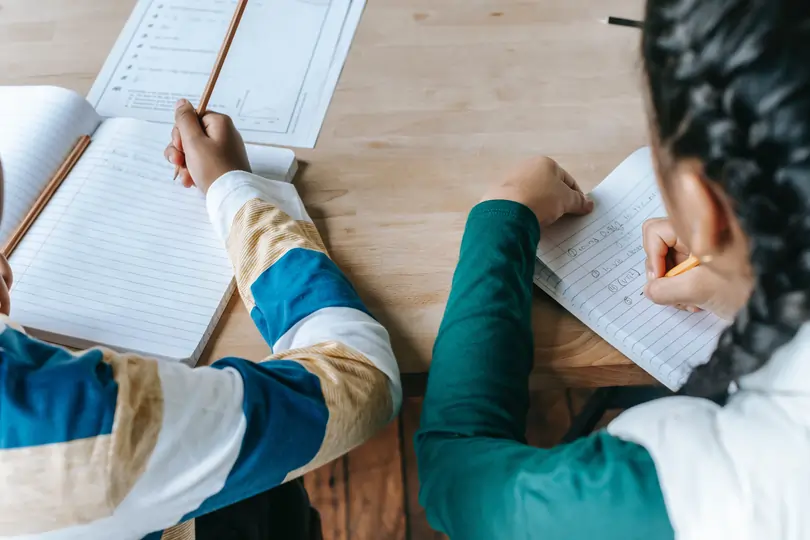Multiplication And Division 1
In this article, we will be learning about Multiplication and Division.
- Understanding Multiplication
Topic Recap:
Understanding multiplication as repeated addition / equal grouping
- We multiply by putting equal groups together. Equal groups contain the same number of objects.
- To multiply, we use repeated addition or multiplication to find the total number of objects.
For example:
\(2 + 2 + 2 = 6\) or \(2 \times 3 = 6\). - We can write a multiplication equation in the following way:

Example:
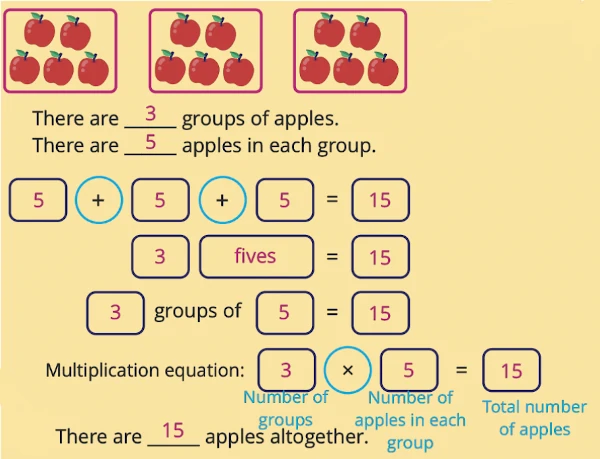
Question 1:
Look at the following picture.

A. There are __________ equal groups.
- \(4\)
- \(2\)
- \(8\)
Answer:
(1) \(4\)
B. Each group has __________ cupcakes.
- \(4\)
- \(2\)
- \(8\)
Answer:
(2) \(2\)
C. Which of the following best represents the picture above?
- \(2\) groups of \(4\).
- \(2\) fours
- \(4\) groups of \(2\).
- \(4 + 4 \)
Answer:
(3) \(4\) groups of \(2\).
Question 2:
How many stars are there altogether?
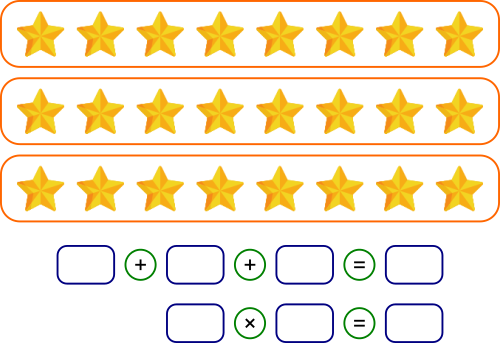
- \(9\)
- \(11\)
- \(21\)
- \(24\)
Solution:
\(\begin{align} 8 + 8 + 8 &= 24 \\[2ex] 3 \times 8 &= 24 \end{align}\)
Answer:
(4) \(24\)
Question 3:
How many bananas are there altogether?
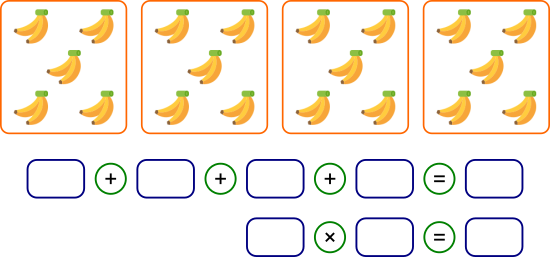
- \(9\)
- \(16\)
- \(20\)
- \(25\)
Solution:
\(\begin{align} 5 + 5 + 5 + 5 = 20 \\[2ex] 4 \times 5 = 20 \end{align}\)
Answer:
(3) \(20\)
Question 4:
Which of the following equations does not represent the following?

- \(5 + 5 + 5 + 5 + 5 + 5 = 30\)
- \(6 \text{ fives} = 30\)
- \(6 \times 5 = 30\)
- \(5 \times 5 \times 5 \times 5 \times 5 \times 5 = 30\)
Answer:
(4) \(5 \times 5 \times 5 \times 5 \times 5 \times 5 = 30\)
1. Understanding Multiplication
To write a multiplication equation, we need to know the number of groups and the number of items in each group. We can then write the multiplication equation in the following way:

To find the total number of pencils in the picture given, we multiply
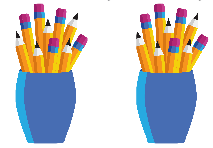
\(10\) by \(2\). This means that a group of \(10\) is multiplied \(2\) times.
\(10 \times 2 = 20\)
We can also multiply \(2\) by \(10\).
\(2 \times 10 = 20\)
‘\(10 \times 2\)’ and ‘\(2 \times 10\)’ have the same values.
Question 1:
Look at the picture below.
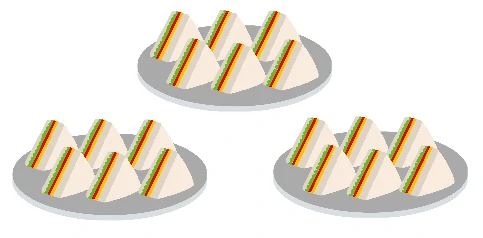
A. Choose the correct option to represent the following statement:
Multiply \(6\) by \(3\).
- \(6 + 3\)
- \(6 × 3\)
Answer:
(2) \(6 × 3\)
B. How many sandwiches are there in the picture above?
- \(9\)
- \(18\)
Solution:
\(6 × 3 = 18\)
Answer:
(2) \(18\)
Question 2:
Which of the multiplication equations represents the following?
Multiply \(8\) by \(4\).

- \(8 + 4 = 12\)
- \(8 \times 4 = 32\)
Answer:
(2) \(8 \times 4 = 32\)
Question 3:
Which of the following sets of multiplication equations best represents the following?
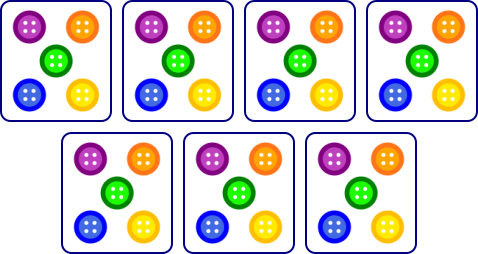
- \(5 \times 7 = 35\) and \(7 \times 5 = 35\)
- \(5 \times 5 = 35\) and \(7 \times 5 = 35\)
Solution:
There are \(7\) groups of \(5\) buttons each.
Answer:
(1) \(5 \times 7 = 35\) and \(7 \times 5 = 35\)
Question 4:
How many stickers are there altogether?
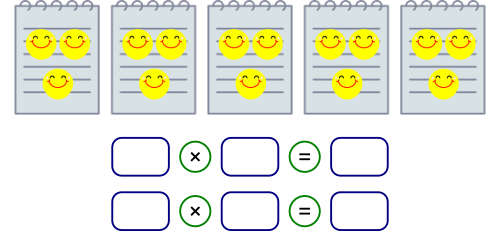
- \(8\)
- \(9\)
- \(15\)
- \(20\)
Solution:
\(5 × 3 = 15\) or \(3 × 5 = 15\)
Answer:
(3) \(15\)
Question 5:
How many tigers are there altogether?
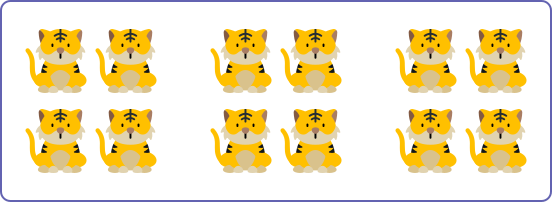
- \(7\)
- \(9\)
- \(12\)
- \(16\)
Solution:
\(4 \times 3 = 12\)
Answer:
(3) \(12\)
Question 6:
How many doughnuts are there in all?

- \(12\)
- \(18\)
- \(27\)
- \(36\)
Solution:
\(9 × 3 = 27\) or \(3 × 9 = 27\)
Answer:
(3) \(27 \)
Question 7:
Look at the picture below.

A. How many jars are there?
- \(3\)
- \(4\)
- \(5\)
Answer:
(2) \(4\)
B. Kelly puts 6 cookies in each jar. How many cookies are there altogether?
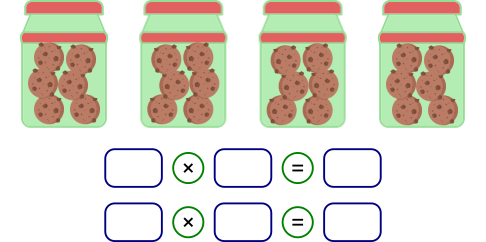
- \(10\)
- \(16\)
- \(18\)
- \(24\)
Solution:
\(4 \times 6 = 24\) or \(6 \times 4 = 24\)
Answer:
(4) \(24\)
Question 8:
There are \(7\) mangoes in each basket. How many mangoes are there altogether?

- \(10\)
- \(18\)
- \(21\)
- \(28\)
Solution:
\(7 × 3 = 21\) or \(3 × 7 = 21\)
Answer:
(3) \(21\)
Question 9:
Ashley collected some bottles for recycling. She put \(9\) bottles in each bag. How many recycled bottles did she collect in all?

- \(14\)
- \(25\)
- \(40\)
- \(45\)
Solution:
\(5 × 9 = 45\) or \(9 × 5 = 45\)
Answer:
(4) \(45\)
Challenge Yourself!
Question 1:
What is the missing number in the given multiplication equation?
\(5 \;\times\) __________ \(= 30\)

- \(5\)
- \(6\)
- \(7\)
- \(8\)
Solution:
There are \(5\) groups with \(6\) ribbons each.
\(5 \times 6 = 30\)
So, the missing number in the equation is \(6\).
Answer:
(2) \(6\)
Question 2:
What is the value of \(\text{A}\)?
\(10 \times \text{A} = 40\)
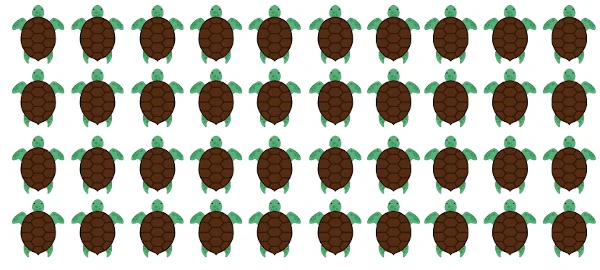
- \(8\)
- \(10\)
- \(3\)
- \(4\)
Solution:
There are \(10\) turtles in each row. There are \(4\) rows.
\(10 \times 4 = 40\)
So, the value of \(\text{A}\) is \(4\).
Answer:
(4) \(4\)
In this article, we have learnt that:
- Multiplication is represented as ‘’\(\times\)'.
- When we multiply two numbers, say \(6\) by \(3\), it is written as \(6 \times 3\).
- The values of \(6 \times 3\) and \(3 \times 6\) are the same.
| Continue Learning | |
|---|---|
| Numbers To 1000 | Multiplication And Division 1 |
| Multiplication And Division 2 | Addition And Subtraction 1 |
| Addition And Subtraction 2 | Fractions 1 |
| Length 1 | Mass 1 |
| Volume 1 | Money 1 |
| Time 1 | Shapes And Patterns |
| Picture Graphs 1 | Model Drawing 1 |
| Model Drawing 4 | |
 SG
SG  VN
VN 

